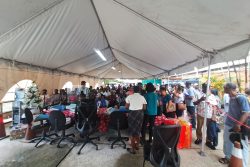When a government has it in mind to follow a course of action which is less than defensible, it likes to present its people with a fait accompli. That way potential critics will be denied information on the background to a decision so they will be unable to ask embarrassing questions. Our governments are usually masters at this ploy, but once in a while they slip up. Such may be the case with the current one, which in a recent instance has not appeared on the face of it to have operated with its usual slickness. Matters which might be connected with the end product emerged to cause contention before it was ever in a position to announce what was promoted as a benefit to the nation.
The ‘benefit’ in question is the opening of a plant by a Chinese-owned seafood company, Grandeast Inc, which is already processing large quantities of shrimp. According to the Ministry of Agriculture it was built at a cost of US$25 million, and boasts modern seafood processing equipment. Grandeast, the public was told, is a wholly owned subsidiary of Fuzhou Aquatic Products Ltd based in Fujian which specialises in the “processing and trading of fishery products”.
As expected, Minister Zulfikar Mustapha welcomed the facility and gushed about how impressed he was with it. He added a few critical details, including that most of the company’s suppliers came from West Demerara, and that there was a ready market in China with room for expansion for this type of processed shrimp. “Our local fishermen would usually discard certain species of shrimp because there was no market for them locally,” he was quoted as saying; “this company has provided that market and fishermen are now encouraged to work more hours weekly to satisfy the demand.”
For his part, Grandeast General Manager Wu Junyu said that the company had provided employment for up to 240 people so far, and that this was just the first phase of the company’s local operations. Apparently phases two and three are coming down the line and since Grandeast was looking to expand, it would require more produce from local fishermen in order to supply its Asian market.
It might be noted that early in 2015 the Fuzho Hongdong Pelagic Fishery company wanted to establish itself here with 30 deep-sea fishing vessels and 120 trawlers, and while the Minister at the time did not sound encouraging, the project was in any case aborted because of the change of government. What one doesn’t know is whether this company is associated at some level with Fuzhou Aquatics; it is very difficult to determine connections in the case of Chinese entities. Even if they are not linked, the Chinese authorities are in any event keen to expand their access to fishing grounds overseas.
As things stand, the US patrols Atlantic waters in partnership with South American nations to counter illegal, unregulated fishing, making it difficult for China to send trawlers to work here. However, there would be nothing to stop a Chinese company from operating through a surrogate as well as behind the smokescreen of a processing plant, and one has to wonder if that is what is happening.
This new development may conceivably have generated less comment had it not been for the fact that it comes in the context of the issuing of two new seabob licences by the Ministry of Agriculture. In the face of queries about the matter which came to light last December, the Minister excelled himself in terms of dissimulation and procrastination, refusing even to answer a parliamentary question. The number of seabob licences is limited in order that the industry will qualify for Maritime Stewardship Council certification that it is sustainable.
Mr Mustapha’s excuse to reporters is that under the agreement with the Guyana Association of Trawler Owners and Seafood Processors, 87 licences are allowed, while at present only 80 are active. As a consequence, he said the issuing of two more would not threaten certification. This is to miss the point: the problem has to do with sustainability, and that will be affected not just by the number of licensees, but the size of the catch.
As we reported yesterday, according to the 2020 MSC surveillance report the harvesting of seabob is limited to a maximum of 87 vessels, with each vessel restricted to 225 days fishing per year. The maximum sustainable average catch rate, the MSC says, was estimated at 630 kg/day while the economic catch rate after consultation with members of the industry was set at 600 kg/day. A catch rate of 540 kg/day was established as a “trigger point” at which concerns about overfishing would be raised and the number of allowable fishing days reduced. In 2019, the total harvest for seabob in Guyana was recorded as 6,662 tonnes at a catch rate of 573 kg/day.
As we reported earlier, the WWF had written the Minister indicating its disquiet that the new licences could lead to overfishing, the loss of certification and the collapse of the industry. He was also informed that a recent stock assessment of Guyana’s seabob population showed that it was fully exploited and had reached the point where the population curve was at the maximum sustainable yield. It might be noted that not just the WWF, but Mr Gopie of GATOSP had expressed concerns about the decline in seabob stocks.
It took an inordinate amount of time before the name of the new licensee was divulged. Eventually the public learned that it was the mysterious Mr Rampersaud Sookhdeo who was supposed to have been active in the Trinidad fishing industry. He is certainly unknown here, and as far as can be established, in T&T as well. We had reported early on that there had been questions about whether Chinese interests were behind the acquisition of the new licences, and in the light of that one has to ask where the trawlers are which Mr Sukhdeo owns? Has anyone seen them? Will he identify where they are currently moored? The public will be tempted to enquire from him whether his entry into our seabob industry will be facilitated by the acquisition of Chinese industrial trawlers, which according to the Yale 360 website “are so large that they scoop up as many fish in one week as local boats from Senegal or Mexico might catch in a year.”
And if Mr Sukhdeo has to acquire boats for his new operation the public will also be tempted to ask whether he is connected to the company which owns the Chinese processing plant.
At the opening of the new plant the Minister seemingly tried to assuage fears that seabob was what was being targeted. He claimed it was only those species of shrimp which the seabob trawlers would discard, because there was no market for them locally, but that the Chinese company had now provided that market. To the average uninitiated person this is a puzzle, since one would have thought that the nets which catch the other shrimp species would also catch some seabob in the process.
Furthermore, as was stated in our report, observers have expressed concern that a range of species could be sold to the Chinese company, expanding fishing in local waters where queries have already been raised about fish stocks. Stabroek News was told by Chief Fisheries Officer Denzil Roberts that the company is currently processing the equivalent of 40 tons/36 tonnes of shrimp and 30 tons/27 tonnes of fish daily. This is more than half of the 55 tons/50 tonnes of shrimp caught daily in 2019. And we have not even reached phases two and three yet.
The other point of significance is that the market for these is China, a voracious consumer of fish products. Our seabob is currently exported to the US and EU, but the Chinese market does not bother with such niceties as MSC approval, which may be why the Minister is so cavalier about matters of certification. If the US and EU won’t buy our seabob, China certainly will. In addition, the public does not know how the new processing plant is affecting the licensed members of GATOSP; they have subsided into silence recently.
Apprehension has been expressed about a possible decline in the availability of shrimp locally, and an inevitable increase in the price which would attend this. Whatever else he has had to say, Minister Mustapha has not offered the public any reassurance in this regard. More important, he has had nothing to say about the conservation of our fish stocks generally, and not just seabob, but then one supposes where the processing plant was concerned, the decision was made at a higher level than him, but that he is the one who has to answer the questions about it.
At the moment West Coast artisanal fishermen have been drafted in to supply the plant, and the hope has been expressed that the Berbice ones will join them. Who is to say if somewhere down the line when phase two comes on stream and larger harvests are required, Chinese finance won’t fund local consortia to acquire large Chinese trawlers? And if that happens and our fish stocks then become exhausted, a whole range of people will be out of work including in the processing plant, and their dependents and communities will suffer hardship.
The people of Guyana were promised transparency and inclusion in August 2020. What has happened to that promise?





